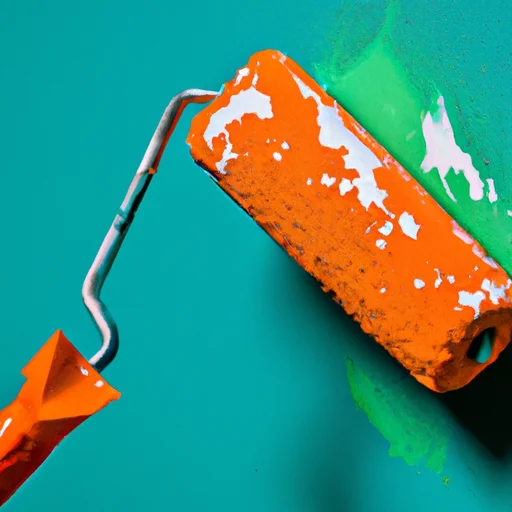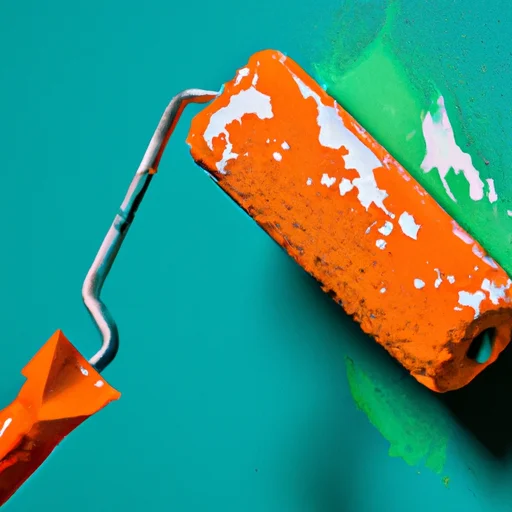Have you ever looked at your walls and thought, “These colors are so dull and boring”? Well, we’ve got some good news for you! In this ultimate guide, we’re going to show you how to say goodbye to those dull walls by painting over old paint.
Now, you might be wondering, “Can you actually paint over old paint?” The answer is a resounding yes! But there are a few things you need to keep in mind before you begin to repaint. We’ll walk you through the steps and share some tips and tricks to ensure that your new paint job looks flawless.
We know that painting over painted walls can seem like a daunting task, but don’t worry, we’ve got your back. In this guide, we’ll dive into the nitty-gritty details – from prepping your walls to choosing the right paint – so that you can achieve a professional-looking result. Get ready to transform your space into something fresh and vibrant!
So, if you’re ready to learn how to paint over old paint and bring new life to your walls, keep reading. We’ll cover everything you need to know to successfully tackle this project and say goodbye to those dull walls once and for all. Get your paintbrushes ready, because it’s time to unleash your inner artist!
Table of Contents
The Ultimate Guide to Painting over Old Paint: Say Goodbye to Dull Walls


Introduction
Understanding the importance of painting over old paint
When it comes to giving your living space a fresh new look, painting the walls is one of the easiest and most effective ways to achieve that. However, the task can become more challenging when you’re dealing with old paint. Understanding the importance of painting over old paint is crucial in ensuring a successful and long-lasting result for your home improvement project.
Benefits of painting over old paint
Painting over old paint offers several benefits that make it a worthwhile endeavor. First and foremost, it saves you time and effort compared to stripping to remove old paint completely. It also provides a cost-effective solution, as you don’t need to invest in expensive paint removers or professional services. Additionally, painting over old paint allows you to change the color or enhance the existing color, giving your walls a fresh and vibrant appearance without a complete overhaul.
Common challenges faced when painting over old paint
While painting over old paint may seem like a straightforward task, it comes with its own set of challenges. One of the primary challenges is ensuring proper adhesion of the new paint to the old surface. If not done correctly, the new paint may peel or crack easily, compromising the overall finish. Another challenge is dealing with any imperfections present in the old paint, such as cracks, holes, or peeling areas. Successfully overcoming these challenges requires careful surface preparation and the right techniques.
Preparing the Surface
Inspecting the condition of the old paint
Before diving into the painting process, it is important to inspect the condition of the old paint. Look for any signs of peeling, chipping, or cracking. Check for areas where the paint may have become uneven or discolored. By assessing the condition of the old paint, you can determine the necessary steps to achieve a smooth and flawless finish.
Cleaning the surface
Cleaning the surface is an essential step in preparing the walls for painting. Use a mild detergent solution and a sponge or cloth to remove any dirt, dust, or grease that may have accumulated over time. Make sure to clean all areas thoroughly, including corners and crevices. A clean surface ensures better adhesion and a smoother finish.
Sanding and smoothing the walls
Sanding the walls helps to create a smooth surface for the new paint to adhere to. Use sandpaper or a sanding block to gently sand the walls, focusing on areas with rough or uneven texture. This step also helps to remove any loose or flaking paint. Remember to wear a mask and protective goggles while sanding to avoid inhaling dust particles.
Removing any loose or peeling paint
Before applying new paint, it is important to remove any loose or peeling paint from the walls. Use a putty knife or scraper to gently scrape away the old paint. Be careful not to damage the underlying surface. Removing loose paint ensures a clean canvas for the new paint and prevents any future peeling or flaking.
Repairing cracks and holes
Inspect the walls for any cracks or holes and repair them before painting. Use spackle or a similar filler to fill in the cracks and holes, ensuring a smooth and even surface. Allow the filler to dry completely and sand it down for a seamless finish. Repairing any imperfections in the old paint ensures a professional-looking result.
Applying primer for better adhesion
To improve adhesion and ensure a consistent finish, apply a coat of primer before painting over the old paint. The primer helps to seal the surface and provides a uniform base for the new paint. Choose and use a primer that is compatible with both the old and new paint types for optimal results.
Choosing the Right Paint
Consider the type of paint already on the walls
When painting over old paint, it is important to consider the type of paint that is already on the walls. This will help determine the compatibility of the new paint and the preparation needed. If you are unsure about the type of paint, you can perform a simple test by applying a small amount of rubbing alcohol on a cotton swab and rubbing it on the wall. If the paint comes off, it is latex or water-based. If it does not, it is oil-based paint.
Selecting a compatible paint type
Choosing a compatible paint type is crucial for a successful paint job. If the existing paint is oil-based, it is recommended to use an oil-based or alkyd paint. If the existing paint is latex or water-based, you can use either latex or water-based paint for the new coat. Make sure to read the manufacturer’s recommendations to ensure compatibility.
Evaluating paint finish options
Consider the desired finish and functionality when choosing a paint finish. Options range from flat to high-gloss finishes, with each offering different characteristics. Flat finishes are ideal for hiding imperfections, while high-gloss finishes provide a durable and washable surface. Satin or eggshell finishes offer a balance between the two. Evaluate your needs and preferences to select the appropriate paint finish.
Using quality paint for long-lasting results
Investing in high-quality paint is essential for achieving long-lasting and beautiful results. While it may be tempting to choose a cheaper option, lower-quality paints can result in an uneven finish, poor coverage, and reduced durability. High-quality paints offer better adhesion, color retention, and resistance to stains and fading. They also tend to require fewer coats, saving you time and effort in the long run.


Gather the Necessary Tools and Materials
Paint brushes and rollers
Choose high-quality paint brushes and rollers for a smooth and even application. Different brush sizes and roller nap lengths are available, so select the appropriate ones based on the size of the area you’re painting.
Painter’s tape and drop cloths
Painter’s tape helps protect trim, windows, and other areas that you don’t want to paint. Drop cloths or plastic sheets are essential for covering and protecting floors and furniture from paint splatters and drips.
Putty knife and spackle
A putty knife is essential for removing loose paint and applying spackle to repair cracks and holes. Choose a sturdy putty knife for better control and precision.
Sandpaper and sanding block
Different grits of sandpaper are needed for sanding walls and achieving a smooth surface. A sanding block provides better grip and control while sanding.
Paint trays and stir sticks
Use paint trays to pour and mix the paint. Stir sticks help ensure consistency by thoroughly mixing the paint before application.
Primer and paint
Choose a primer that is compatible with the existing paint and the new paint type. Depending on the size of the area you’re painting, determine the appropriate amount of paint needed and purchase accordingly.
Preparing the Room
Removing furniture and covering floors
Start by removing furniture from the room or moving it to the center and covering it with drop cloths. This protects your belongings from accidental paint splatters or spills. Cover the floors with drop cloths as well to prevent any damage or stains.
Protecting fixtures and outlets
Use painter’s tape to protect light fixtures, outlets, and switches from paint. Simply cover the areas you want to keep paint-free with tape, ensuring a clean and professional finish.
Taping off trim and windows
Apply painter’s tape along the edges of trim, baseboards, windows, and any areas that you don’t want to paint. This step ensures a crisp and clean separation between the painted walls and the untouched surfaces.
Creating a clean and organized workspace
Before you start painting, create a clean and organized workspace. Remove clutter and cover any remaining furniture or items with drop cloths. This allows for easier mobility and a more focused painting process.
Applying the Paint
Choosing the right technique for the desired finish
Different techniques yield different finishes, so consider the desired outcome before choosing a painting technique. Brushing with a paintbrush provides a textured finish, while using a roller gives a smoother finish. Experiment with different techniques to achieve the desired look.
Cutting in and edging the walls
To achieve a professional look, start by cutting in the edges and corners of the walls using a paintbrush. This technique ensures clean and precise lines between the painted walls and the adjacent surfaces, such as trim or ceilings.
Using even and consistent strokes
Whether you’re using a brush or a roller, apply the paint with even and consistent strokes for a uniform finish. Avoid excessive pressure, which can cause drips or uneven paint application. Take your time and work in small sections, ensuring thorough coverage.
Applying multiple coats if necessary
In some cases, multiple coats of paint may be necessary to achieve the desired color and coverage. Allow the paint to dry between coats according to the manufacturer’s instructions. This ensures proper adhesion and prevents smudging or streaking.
Allowing proper drying time between coats
Proper drying time between coats is crucial for achieving a flawless finish. Follow the manufacturer’s guidelines for drying times and ventilation. Avoid touching or disturbing the painted surface until it is fully dry to avoid smudges or imprints.
Adding Finishing Touches
Removing painter’s tape before the paint fully dries
To achieve clean and crisp lines, remove the painter’s tape before the paint fully dries. This prevents the paint from peeling off or creating uneven edges. Carefully peel off the tape at a 45-degree angle.
Cleaning up any drips or smudges
Inspect the painted walls for any drips or smudges and clean them up promptly. Use a damp cloth or sponge to gently remove any accidental paint marks. Remember to use gentle motions to avoid damaging the fresh paint.
Inspecting the painted surface for touch-ups
After the paint has dried completely, inspect the painted surface for any touch-ups needed. Look for areas that may have been missed or require additional coverage. Use a small brush or roller to touch up these areas, ensuring a seamless and uniform finish.
Replacing furniture and rearranging the room
Once the paint has fully dried and you’re satisfied with the results, replace the furniture and rearrange the room as desired. Admire the transformation and enjoy the fresh and vibrant walls that have breathed new life into your living space.
Maintaining and Caring for the Newly Painted Walls
Cleaning and dusting the walls regularly
To maintain the beauty of your newly painted walls, clean and dust them regularly. Use a soft cloth or duster to remove any dirt or dust buildup. Avoid using abrasive cleaners or harsh chemicals, as they can damage the paint finish.
Avoiding harsh chemicals and abrasive cleaners
Harsh chemicals and abrasive cleaners can strip away the paint or cause discoloration. Opt for mild, non-abrasive cleaners when necessary, and test them in an inconspicuous area before applying them to the entire wall.
Repairing any minor damages promptly
Address any minor damages to the painted walls promptly to prevent further deterioration. Whether it’s a small scratch or a minor chip, touch up the affected area with paint to maintain a seamless and flawless look.
Refreshing the paint as needed
Over time, the paint may start to fade or show signs of wear and tear. When this happens, consider refreshing the paint by applying a new coat. This helps maintain the vibrant and fresh appearance of your walls for years to come.
Common Mistakes to Avoid
Skipping surface preparation
Skipping or rushing through the surface preparation process can lead to adhesion issues and a poor paint finish. Take the time to inspect, clean, and repair the walls before applying new paint for the best results.
Using low-quality paint or tools
Using low-quality paint or tools may save you money initially, but it can result in a subpar finish and premature paint failure. Invest in high-quality paint and tools to achieve a professional-looking result that will withstand the test of time.
Not allowing enough drying time
Not allowing enough drying time between coats or before removing painter’s tape can result in smudging, peeling, or imprints. Follow the manufacturer’s recommended drying times to ensure a flawless finish.
Applying too thick or too thin coats
Applying the paint too thickly can result in drips or an uneven finish, while applying it too thinly can result in streaks or patchy coverage. Aim for a consistent and even application for the best results.
Neglecting to protect the surrounding areas
Failing to protect the surrounding areas, such as floors, furniture, and fixtures, can lead to paint splatters and stains. Take the time to cover and protect these areas before starting the painting process.
Conclusion
Achieving beautiful and vibrant walls by painting over old paint
Painting over old paint is a cost-effective and efficient way to enhance the appearance of your living space. By following the steps outlined in this guide, you can achieve beautiful and vibrant walls that breathe new life into your home.
Enhancing the overall aesthetics of your living space
A fresh coat of paint can dramatically transform the overall aesthetics of your living space. Whether you’re looking to change the color, refresh the existing color, or simply give your walls a clean and polished look, painting over old paint is an excellent solution.
Increasing the value of your home
Updating the paint on your walls not only improves the visual appeal of your home but also adds value. Potential buyers or renters are more likely to be attracted to a home with well-maintained and freshly painted walls, making it an investment that pays off in the long run.
Saying goodbye to dull walls
As you bid farewell to dull walls, embrace the opportunity to express your personal style and create a space that reflects your personality. With the knowledge and tips provided in this guide, you can confidently embark on your painting journey and say goodbye to dull walls once and for all.


